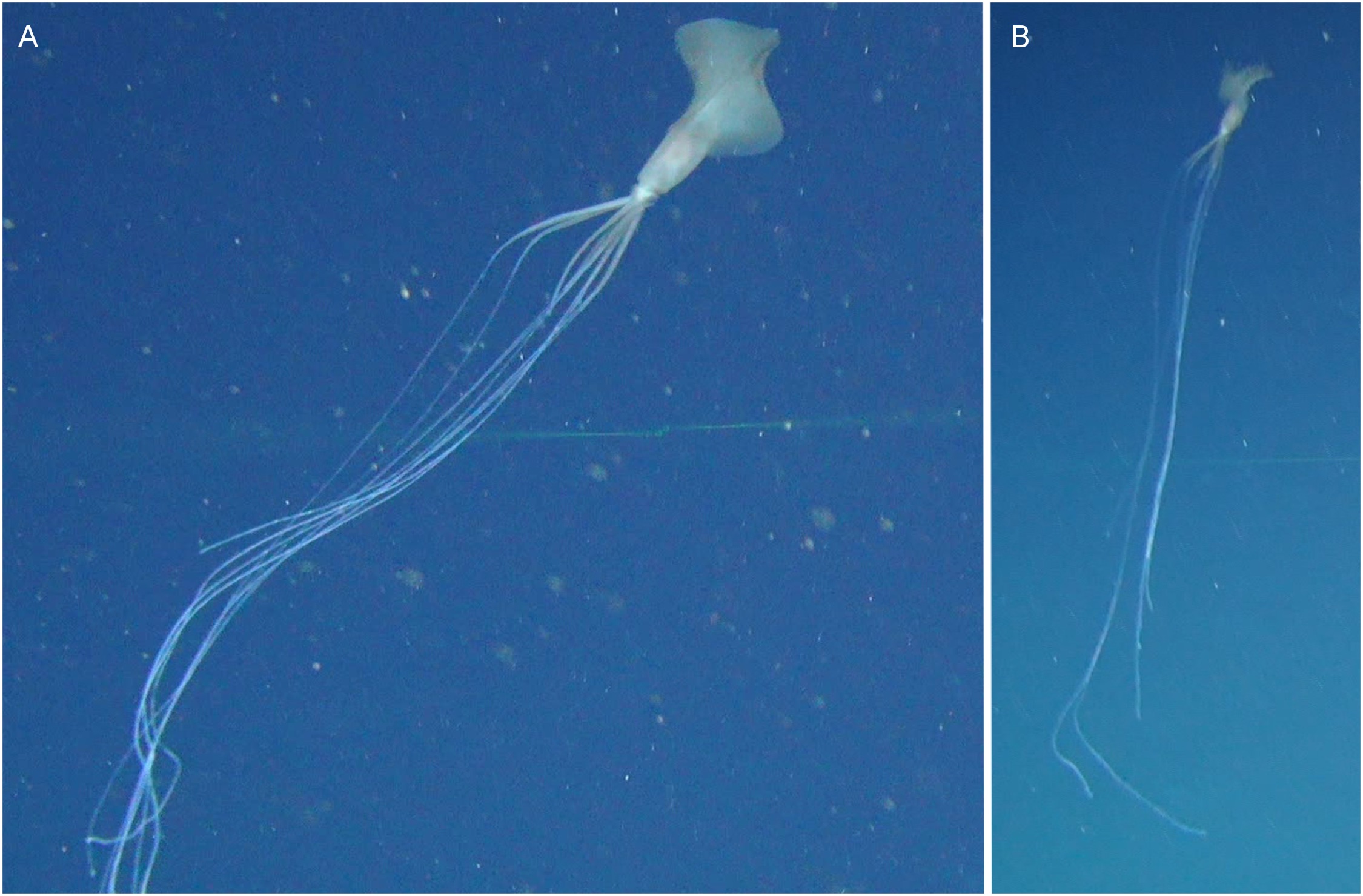Rare squid with 'elbow' tentacles baffles scientists in spooky new footage
The squid's tentacles are taller than an average human, but its body is small as a dollar bill.

It looks like an alien — head dwarfed by enormous flapping fins, body blobbing through dark water, thin blue tentacles streaming behind it in a tangle of neon spaghetti. But despite its otherworldly appearance, the elusive cephalopod known simply as the Bigfin squid (Magnapinnidae) may be more common in Earth's deep oceans than scientists ever knew.
In the 113 years since its discovery, the Bigfin squid has been spotted in the wild only 12 times around the world. Now, a study published Wednesday (Nov. 11) in the journal PLOS ONE, adds five new sightings to the tally, all of them captured thousands of feet below the surface of the Great Australian Bight in South Australia.
Not only do the sightings mark the first time that Bigfin squid have been seen in Australian waters, but it's also the first time that five of them have been caught hanging out together in one place. The resulting footage — captured by underwater cameras trailing behind a large research vessel — provides an unprecedented look at the bizarre cephalopod's anatomy and behavior, lead study author Deborah Osterhage told Live Science.
Related: 8 crazy facts about octopuses
"I was stunned and excited when I first saw the Bigfin squid in a photo collected by our camera," Osterhage, a marine researcher with the Commonwealth Scientific and Industrial Research Organisation (or CSIRO, Australia's government science agency), said in an email. "I recognized it immediately, with its distinctive large fins and extremely long and slender arms and tentacles."
Scientists identified the first Bigfin squid specimen, which was caught by fishers near Portugal, in 1907. It took more than 80 years before anyone saw one in the wild, swimming 15,535 feet (4,735 meters) underwater off the coast of Brazil in 1988. The squid is distinct, with giant fins jutting off of its body like Dumbo the elephant's ears. These fins are as wide as the squid's upper body (or mantle) is long, Osterhage said, and Bigfins propel themselves through the water by flapping them like wings.
That's nothing new for cephalopods (just ask the adorably named Dumbo octopus), but what really sets the Bigfin squid apart from its other deep-sea cousins are incredibly long, stringy tentacles. Now, researchers have a better idea of just how long and stringy they can get. In the new study, which culminates from more than 40 hours of underwater observations at depths of 3,100 to 7,900 feet (950 to 2400 m) below the surface, the team not only sighted the gaggle of Bigfins swimming through the Bight, but they even measured one of them with more accurate methods than ever before.
Get the world’s most fascinating discoveries delivered straight to your inbox.
"We were able to measure [one specimen] with lasers — a first, as previous measurements are estimates based on nearby objects," Osterhage said. "It measured 5.9 feet (1.8 m) in length. The specimen's mantle was around 6 inches (15 centimeters), with the remaining 5.9 feet [1.8 m] made up of those long arms and tentacles."
Think, an upper body as long as a U.S. dollar bill, trailing tentacles as long as U.S. tennis champ Serena Williams. And that may even be on the small side; according to Osterhage, previous studies have estimated that Bigfin squid can grow to 22 feet (7 m) long.
Stranger still may be how the squids hold those tentacles. Unlike most cephalopods, whose tentacles hang below their bodies, the Bigfin squid's appendages jut out at perpendicular angles to their mantles before bending and curling away, making each tentacle look like an "elbow," Osterhage said.
During one of the team's sightings, a Bigfin surprised the researchers by raising one long arm above its body and holding it there — a baffling behavior never before seen in squids, the researchers wrote. The posture could have something to do with filter feeding, they speculated, but the truth is nobody knows for sure. Finding the answer to that (and many other outstanding questions about the oddball squid) will require many more encounters in the wild.
"There is much to learn about the Bigfin squid — basic questions such as what it feeds upon, how it reproduces, etc., are still unknown," Osterhage said. "But one exciting thing about our paper is that all five specimens were found clustered in close spatial and temporal proximity of each other, which has never been seen before."
Why they were clustered together is yet another question without an answer, but this behavior is often associated with survival or mating opportunities, Osterhage said. Future sightings will help determine the squid's specific needs, she added — but for now, maybe it's safest just to say that aliens of a feather (or tentacle) stick together.
Originally published on Live Science.

Brandon is the space / physics editor at Live Science. With more than 20 years of editorial experience, his writing has appeared in The Washington Post, Reader's Digest, CBS.com, the Richard Dawkins Foundation website and other outlets. He holds a bachelor's degree in creative writing from the University of Arizona, with minors in journalism and media arts. His interests include black holes, asteroids and comets, and the search for extraterrestrial life.



